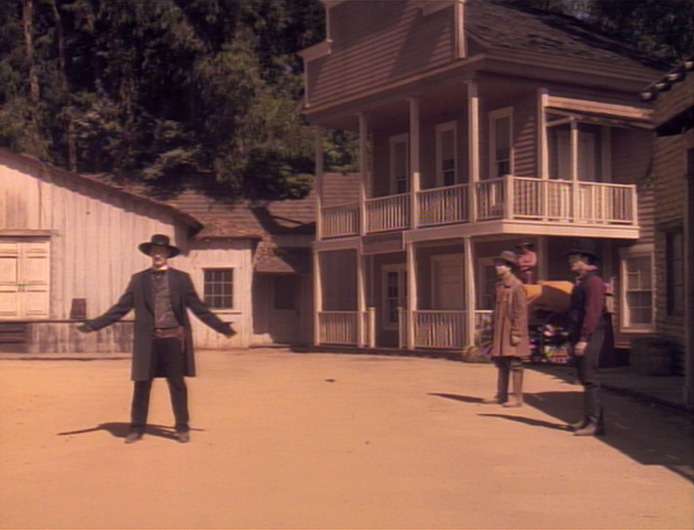 The holodeck often provides great chances for the characters to explore their inner fantasies and the writers to explore the characters’ lives outside of their jobs, yet there is something very striking about the early holodeck episodes—how very Caucasian the fantasies actually are. Almost every holodeck episode is based around standard Caucasian cultural icons: Restoration plays, The Three Musketeers, Sherlock Holmes, the Wild West, James Bond, Jane Eyre, and more. But the utopian future of Trek could easily have included diverse cultural adventures in the holodeck, and there is still an opportunity for the future to use the holodeck to embrace IDIC in new ways.
The holodeck often provides great chances for the characters to explore their inner fantasies and the writers to explore the characters’ lives outside of their jobs, yet there is something very striking about the early holodeck episodes—how very Caucasian the fantasies actually are. Almost every holodeck episode is based around standard Caucasian cultural icons: Restoration plays, The Three Musketeers, Sherlock Holmes, the Wild West, James Bond, Jane Eyre, and more. But the utopian future of Trek could easily have included diverse cultural adventures in the holodeck, and there is still an opportunity for the future to use the holodeck to embrace IDIC in new ways.
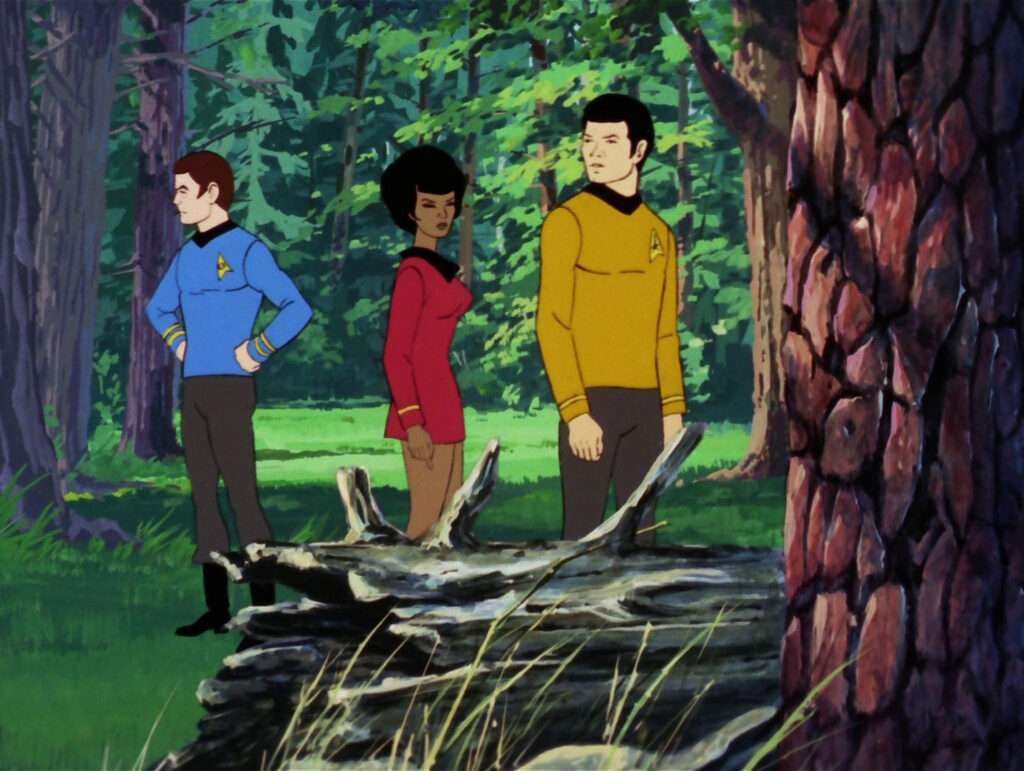
The very first episode that had a predecessor to the holodeck, “The Practical Joker” from The Animated Series, referred to it as a recreation room. Even though Uhura and Sulu are present as two of the main characters of this subplot of the episode, it does not feature diverse fantasies. She does choose a forest for her adventure, but the image is of a European style forest, even though this would have been the perfect time to showcase plants from Kenya, Uhura’s home country, or other countries in Africa. This absence of more diverse plants is even more glaring as Sulu often had plants from across the galaxy in his collection. Why not show off the creativity of the Filmation crew by featuring more diverse plants?
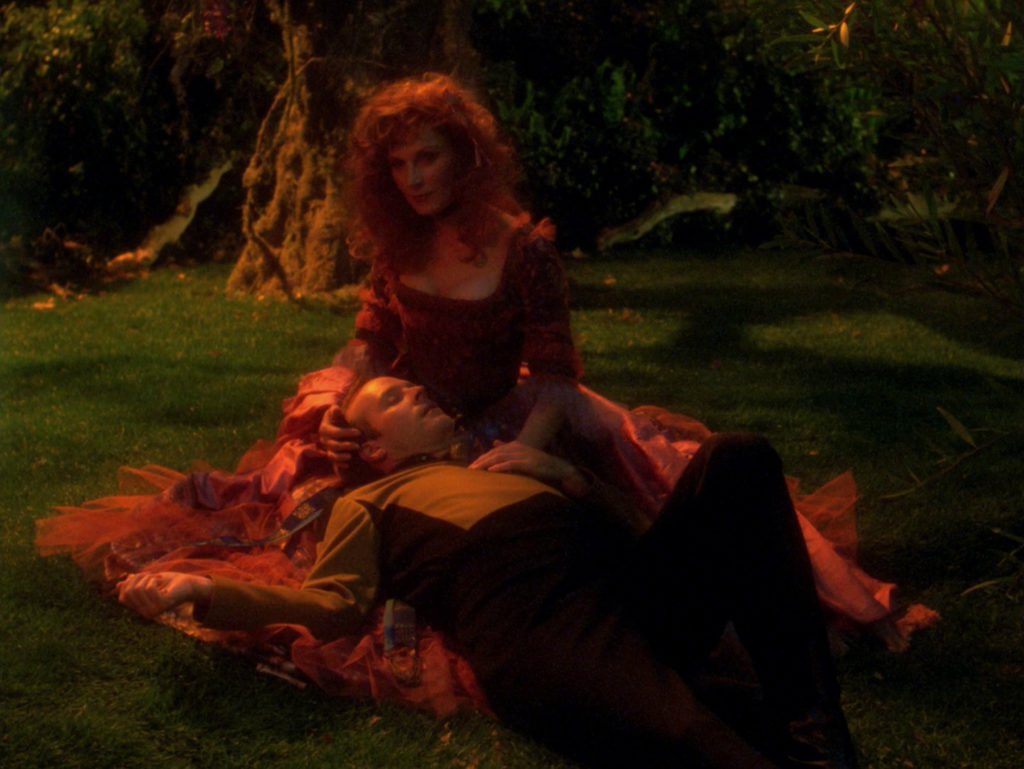
Reginald Barclay’s holodeck programs in The Next Generation are also decidedly Euro-centric. When the main bridge crew ends up in his holodeck simulation they find holographic versions of themselves dressed in Restoration era garb, part of a parody of The Three Musketeers . The eurocentrism of the holodeck adventure is especially jarring as Alexandre Dumas was one quarter African and was very proud of his heritage. While Geordi La Forge’s presence does predate a recent BBC production where one of the Musketeers was Anglo-African in honor of Dumas, there is no deep exploration of this. Deanna Troi’s presence in the same holodeck program as “The Goddess of Empathy” also recalls how many European cultures heold the ancient Greeks and Romans up as an ideal civilization and adapted mimicked many of their cultural traditions or based their own cultures on Greek and Roman. Trek is no stranger to this as The Original Series often encountereds species that seemed to be “ancient Romans orand Greeks in Space.”
TNG missed the opportunity to really explore diversity in the Restoration period in this episode. The King of England during the Restoration era, Charles II, was known for his darker skin tone, to the point that his mother nicknamed him “The Black Boy King of England.” Why not take the opportunity to explore Charles’ identity, or highlight the long presence of Black people and other people of color in Europe?
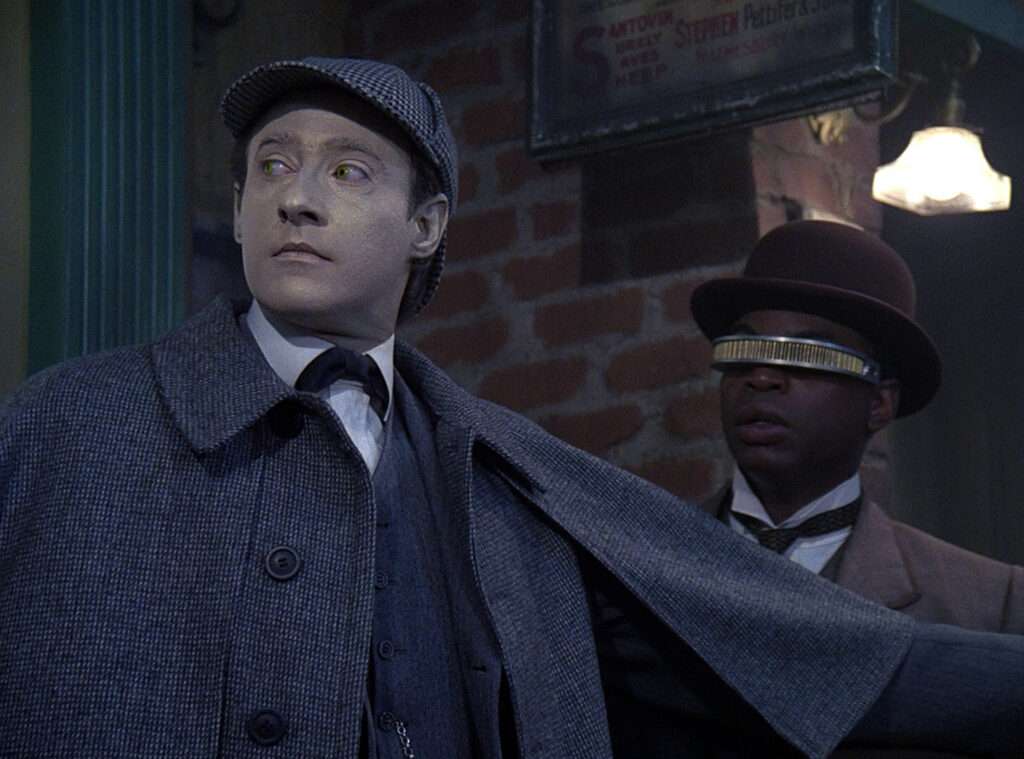
“Elementary, My Dear Data” is yet another Euro-centric holodeck adventure where the literally white-skinned Data is the super-intelligent Holmes while Geordi La Forge is Watson, Holmes’ sidekick who is sometimes infantilized or viewed as dumb. While none of the holodeck characters refer to La Forge with slurs, it is also interesting to note an unexpected parallel in modern depictions of the Holmes canon, in particular the CBS adaptation “Elementary,” where Watson is portrayed by Lucy Liu, yet Holmes is still portrayed by a white actor. Does this indicate some bias in casting for adaptations of Sherlock Holmes?
Nor is this the only example of Eurocentric literary holodeck adventures. Picard is particularly fond of the noir adventures set in the world of Dixon Hill. Even though the Dixon Hill stories are set in San Francisco, no Black or Asian American characters are present in any of the three original holodeck stories. Guinan does join Picard in one of the Dixon Hill stories, as does Lily in Star Trek: First Contact, but they do not portray a particular character from the series of novels. Does that indicate Dixon Hill novels are very white, or that Picard does not know any of the characters of color in the Dixon Hill canon?
Yet one of the most western-centric holodeck episodes comes from “A Fistful of Datas.” Set in a fictionalized version of the American Wild West, an error populates the adventure with multiple roles played by Brent Spiner’s Data, hence the title. Historically, more of the characters should have been portrayed by Black actors, as a quarter of all known cowboys were Black. This includes well known cowboys such as Bass Reeves, who has now been the subject of books for readers of all ages and even a movie in recent years; Bass Reeves in particular has become well known as the inspiration for The Lone Ranger. There is even an autobiography from Nat Love, from the early 1900s, who wrote about his experiences as a Black cowboy. One of these early Black cowboys, Bill Pickett, developed a special roping technique that was recorded in an early silent movie. Maybe the episode should have been “A Fistful of La Forges” with Levar Burton’s Geordi La Forge appearing everywhere?
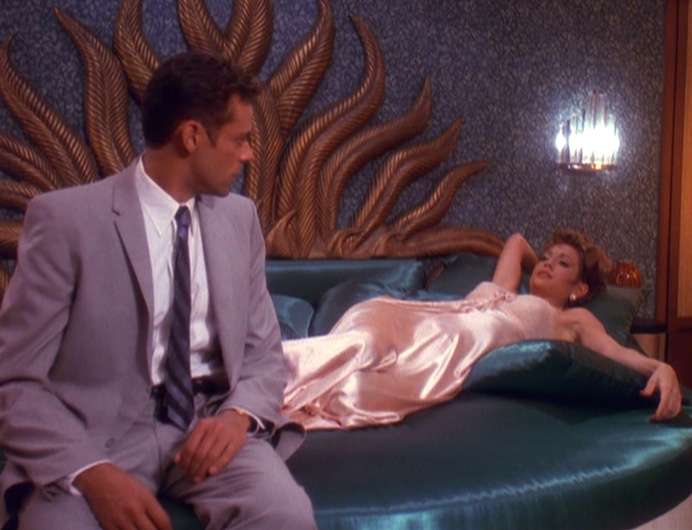
Unfortunately, Deep Space Nine had very few holodeck episodes, often leaving the holosuite references as side mentions. Yet almost all of these references are also focused on European or American culture and history. Jadzia Dax and Kira Nerys come out in costume from a recreation of King Arthur’s court in one instance, while Julian Bashir and Miles O’Brien fought against holographic Vikings attacking an Irish monastery, flew in the Battle of Britain, and defended the Alamo against the Mexican army. Even Bashir’s main holodeck adventure, “Our Man Bashir,” is a James Bond pastiche with Julian Bashir as Bond. Why couldn’t a holosuite episode feature a story related to Bashir’s heritage? Early in DS9 we do briefly meet Buck Bokai, a holographic version of a real Asian American baseball player Benjamin Sisko is a fan of.
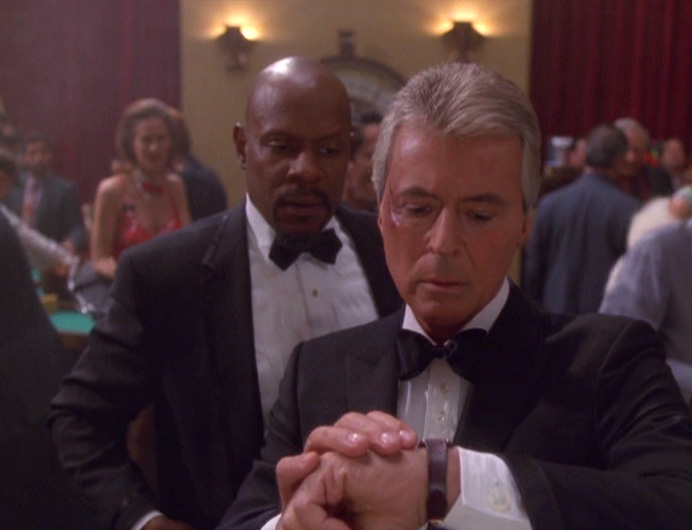
“Badda-Bing, Badda-Bang” actually introduces an interesting idea about holodeck adventures. Vic Fontaine is facing threats from mobsters and asks the others to help save his casino. Many of the others jump at the chance to pull off a counter heist, but Sisko tries to avoid this. When Kassidy Yates confronts him to ask why he is so against this, Sisko replies:
You want to know? You really want to know what my problem is? I’ll tell you. Las Vegas nineteen sixty two, that’s my problem. In nineteen sixty two, black people weren’t very welcome there. Oh, sure they could be performers or janitors, but customers? Never.
Clearly Sisko knows about the oppression his ancestors would have faced and his reluctance to participate might indicate he would prefer to explore a holosuite program without the same baggage, yet we never hear reference to him doing this or Quark developing a program for him, even though Quark did make custom programs for others. Does this mean that there is a Western bias in available programs and there are fewer non-white or non-western program developers? Are the works of more diverse creators underrepresented in the default program catalogue?
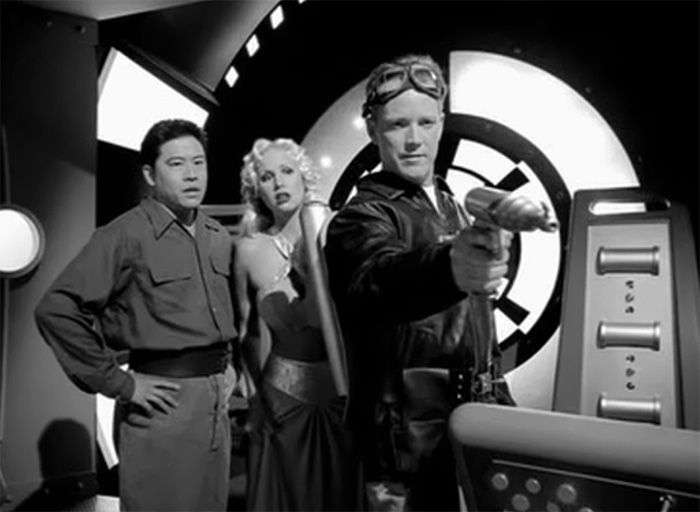
Voyager continues to feature European and American culture. Tom Paris’ Captain Proton adventures are closely related to the Flash Gordon serials, which featured villains who were little more than harmful Asian stereotypes. It is also interesting to note that Harry Kim is cast as Buster Kincaid, Captain Proton’s assistant who needs to be rescued by Proton, much like La Forge was Watson. Then there is Fair Haven, the idealized Irish village holodeck program the crew uses en masse. Yet one of the most striking examples of the white western bias of the holodeck programs comes from one Janeway briefly uses, an obvious variation on Jane Eyre. This choice becomes even more problematic in light of the truth about Bertha Mason, the wife discarded in the original novel due to the perception of her as a ‘madwoman’. Bertha Mason is described in the novel as animalistic and violent, dehumanizing her, which becomes even more troubling in light of her Creole heritage. By describing Bertha Mason as Creole, she is not only ‘Othered’ due to being multiethnic, but her mental illness, if it does exist, is belittled to the point the audience sides with Rochester even though he imprisoned her and lies to Jane, intending to commit bigamy. If Janeway had continued her holonovel, would Rochester-inspired Lord Burleigh have revealed his own discarded wife of color?
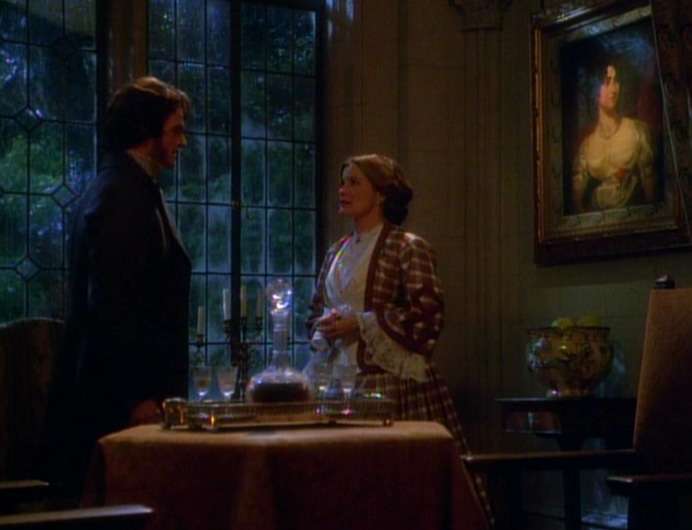
Even though the introduction of the holodeck into Trek canon allows the audience to see the characters outside of their Starfleet duties, these holodeck adventures have been overwhelmingly inspired by European and white American culture. Almost every piece of literature or pop culture explored in the holodeck is based on something created by white authors for a white audience. Even when Trek itself has celebrated diversity in casting actors of color into prominent roles, the holodeck adventures need to embody this too. Where are the holodeck adventures abouts Nzinga? What about the Tuskegee airmen? Surely there are some novels by writers of color Trek could use for holonovels?